Introduction to the Future of Cyber Insurance
Cyber risks continue to evolve faster than most businesses can keep up with. In just the past few years, ransomware has shifted from an occasional disruption to a multi-billion-dollar criminal enterprise. Artificial intelligence (AI) has enabled both more sophisticated attacks and more effective defenses. Regulators are imposing stricter requirements, and insurers are responding with tougher underwriting standards.
For small and mid-sized businesses, this changing environment can feel overwhelming. Cyber insurance is no longer just a “nice-to-have” add-on; it has become a central part of a company’s overall risk management strategy. Understanding where the market is headed in 2025 will help business owners prepare for what comes next.

What is the Future of Cyber Insurance?
Brief Overview
Cyber insurance is designed to transfer part of the financial risk associated with cyber incidents such as data breaches, ransomware attacks, or business email compromise. In 2025, it is becoming less about reacting to an event and more about incentivizing proactive cybersecurity. Carriers are demanding higher standards from their insureds and offering enhanced protection to those who meet them.
Importance of Cyber Insurance in 2025
Businesses now operate in an environment where a single breach can shut down operations, trigger regulatory penalties, and damage customer trust. Cyber insurance helps cover the direct costs of an incident—such as forensics, legal fees, and data restoration—while also providing resources like breach coaches and crisis communication experts.
With threats growing more complex and regulations expanding, cyber insurance serves two roles in 2025: financial protection and compliance support.
Why the Future of Cyber Insurance Matters for Businesses
Benefits of Understanding Trends
Businesses that stay ahead of cyber insurance trends gain real advantages:
- Stronger negotiating position with carriers when you can demonstrate mature cybersecurity practices.
- Cost savings through lower premiums or broader coverage when controls are in place.
- Fewer surprises when applying for coverage or renewing policies, since you know what insurers will require.
Impact on Industry Trends
In 2025, insurers are focusing on the industries most vulnerable to cyber events: healthcare, financial services, professional services, retail, and nonprofits. Contractors and service businesses that handle sensitive client data are also seeing increased scrutiny. Insurers are rewarding organizations that implement controls such as multifactor authentication (MFA), endpoint detection and response (EDR), and secure backup protocols.

Key Components of the Future of Cyber Insurance
1. Stricter Underwriting Standards
Carriers are no longer offering coverage without proof of robust cybersecurity. Businesses should expect:
- Lengthy security questionnaires during the application process.
- Requirements to demonstrate controls such as MFA, patch management, and employee training.
- Potential third-party security assessments before binding coverage.
Without these measures, many businesses will find themselves declined or only offered limited coverage.
2. Premium Increases and Market Hardening
The cyber insurance market remains hard. While rates have stabilized compared to the dramatic increases of 2021–2023, they are not decreasing. Businesses in high-risk sectors may still see double-digit premium growth. Even businesses outside these sectors can expect increases if they lack key security controls.
3. Expanded Coverage Areas
Coverage in 2025 is evolving to address the realities of modern threats:
- Ransomware Response: Coverage now often includes negotiation services and payment facilitation (within legal limits).
- Social Engineering & Funds Transfer Fraud: More policies are extending coverage for losses caused by phishing and fraudulent wire requests.
- Supply Chain Attacks: Carriers are expanding coverage to address vendor-related incidents, recognizing that many breaches occur through third parties.
- Reputational Harm: Some policies now include resources for PR and brand restoration after a cyber event.
At the same time, businesses should watch for silent cyber exclusions on other policies, such as property or general liability, which may now specifically exclude cyber-related losses.
4. Regulation-Driven Changes
Compliance pressures are rising:
- New York Department of Financial Services (NYDFS) Part 500 continues to enforce strict cybersecurity requirements for financial institutions and insurance companies.
- FTC Safeguards Rule requires certain businesses to maintain robust cybersecurity programs.
- SEC rules increase cyber incident reporting obligations for public companies.
- Global regulations such as GDPR and emerging U.S. state-level privacy laws expand compliance exposure.
Cyber insurance policies in 2025 often integrate compliance resources, helping businesses avoid fines and penalties.
5. Technology’s Influence
Technology itself is shaping the market:
- Artificial Intelligence is enabling attackers to launch more convincing phishing campaigns and identify system vulnerabilities faster. At the same time, insurers are promoting AI-driven security tools to improve defense.
- Managed Detection and Response (MDR) services are becoming a standard expectation for insureds, providing real-time threat monitoring and response.
- Partnerships between insurers and tech vendors are on the rise, offering policyholders discounted security tools or access to vetted service providers.
Preparing Your Business for the Future of Cyber Insurance
To remain insurable and manage costs effectively, businesses should:
- Conduct an annual cyber risk assessment to identify vulnerabilities.
- Document policies and procedures, which insurers and regulators will expect to see in writing.
- Invest in core cybersecurity controls such as MFA, regular patching, encrypted backups, and employee training.
- Build relationships with trusted insurance advisors who understand the nuances of cyber coverage and carrier expectations.
These steps not only strengthen your security posture but also position you to secure the most favorable coverage.
Conclusion
Cyber insurance is no longer optional. In 2025, it is a business necessity and a key component of risk management. The future of cyber insurance will reward businesses that proactively invest in security, comply with regulations, and understand how policies are evolving.
At JWI Group, we help businesses navigate this complex environment. From assessing your cyber risk to finding coverage that aligns with your security practices, our goal is to make sure you’re protected against the threats of today and tomorrow.
Call to Action: Ready to review your cyber risk strategy? Request a cyber insurance quote today.
Frequently Asked Questions About the Future of Cyber Insurance
Q1: Will cyber insurance premiums go down in 2025?
Premiums are expected to stabilize compared to the steep increases of recent years, but significant decreases are unlikely. Businesses with strong cybersecurity controls may see more favorable pricing and broader coverage options.
Q2: What cybersecurity measures are insurers requiring in 2025?
Insurers typically expect multifactor authentication (MFA), regular data backups, endpoint detection and response (EDR), employee training, and a documented incident response plan. Without these, coverage may be limited or denied.
Q3: Does cyber insurance cover ransomware payments?
Many policies do cover ransomware payments, provided they are legal under U.S. and international regulations. Coverage also often includes negotiation support and forensic services to minimize damage.
Q4: How does cyber insurance help with regulatory compliance?
Cyber insurance can provide access to legal counsel, breach coaches, and compliance resources to help businesses navigate regulatory obligations under laws like NYDFS Part 500, FTC Safeguards Rule, and GDPR.
Q5: What industries are most affected by changes in cyber insurance?
Healthcare, financial services, professional services, retail, and nonprofits face the greatest challenges due to the volume of sensitive data they handle. Contractors and service businesses that store client data are also under greater scrutiny.
Q6: Can small businesses still qualify for cyber insurance?
Yes, but carriers are raising the bar. Small businesses that adopt affordable security controls—like MFA, backup systems, and employee awareness training—are more likely to qualify and secure competitive coverage.
